 Fighters of Lanzhou MAC in confrontation training
Fighters of Lanzhou MAC in confrontation training
 3D printing to trigger third industrial revolution
3D printing to trigger third industrial revolution
 Top 10 brands that win rich women's hearts
Top 10 brands that win rich women's hearts
 Deng Xiaoping: 'I have a clear conscience all my life'
Deng Xiaoping: 'I have a clear conscience all my life'
 Xi Jinping: 'The people are our strength'
Xi Jinping: 'The people are our strength'
 Amazing cliff diving in cold winter
Amazing cliff diving in cold winter
 Enjoy Sochi 2014 in slow motion
Enjoy Sochi 2014 in slow motion
 University student sentenced to death for poisoning roommate
University student sentenced to death for poisoning roommate
 Chinese lunar New Year celebrated in San Francisco
Chinese lunar New Year celebrated in San Francisco
TORONTO, March 5 -- From Emperor Chenghua's extensive art collection to Empress Dowager Cixi's nail guards, the mysterious lives within Beijing's iconic 600-year-old imperial home are brought to life in Toronto's Royal Ontario Museum (ROM) for the very first time.
The Forbidden City: Inside the Court of China's Emperors exhibit, unveiled on Wednesday, is part of ROM's centerpiece in its year-long centennial celebrations, and museum CEO Janet Carding said making this the focus of their 100th anniversary was a no brainer.
"Our Chinese collection is internationally renowned and we've been working with our Chinese partners for many years, and we thought, this is a great opportunity to show something which has never been seen in Canada before," she explained.
Running from March 8 to Sept. 1, approximately 250 artifacts will be exhibited, roughly 80 of which had never been seen outside the Forbidden City before their transportation to Canada.
Featuring bathtubs, robes, stationery and small textile items used in the everyday life of the 24 emperors, concubines, eunuchs, and court officials straight from Beijing's Palace Museum, the ROM aims to showcase what Chinese imperial life was like.
The project has taken nearly two years to complete, and opened on Wednesday in the presence of Chinese Ambassador Zhang Junsai, Ontario's Premier Kathleen Wynne, and a number of dignitaries.
During his speech, Zhang called the exhibit one of the most important cultural events between China and Canada in recent years.
"Historic and cultural differences between China and the West have also left us with different values, and only by respecting and appreciating our differences can we build a harmonious world," said Zhang. "So this exhibit will definitely promote mutual understanding and friendship between our two countries and our two peoples."
The media were treated to a preview of what visitors will get to see when the exhibit officially opens to the public on Saturday.
Divided into five sections, it is designed to make visitors feel as if they are walking through the Forbidden City architecture of 980 buildings and 9,000 rooms.
Visitors will first enter the Outer Court, a place where those the emperor had invited into the palace would congregate. There are ceremonial bells, suits of armour, weapons and large-scale paintings displayed to tell the story of the emperors' governing and military battles.
Visitors will then make their way to the Inner Court, a residential space where only the imperial family and their eunuchs lived.
The climactic highlight is the last section, which takes visitors into the emperors' study, the most private space in the palace.
The museums's senior curator Chen Shen said visitors will not just get to see the emperor's stationery items, but also learn about Emperor Chenghua's appreciation of the arts.
"You're going to see in this room stationeries, what kind of pen he's using, ink stones, ink washers, all these things (that are) associated with his really private life and certainly his products, his paintings," said Shen. "He was like a curator. Sometimes I say he's the first curator of the Forbidden City because he made a catalogue of his collections, he classified his collections."
Carding said their ultimate goal is to use this exclusive collaboration between the ROM and the Palace Museum to show visitors a side of the Forbidden City that they don't always get to see.
"I think that's been something which our curators have been able to bring to life," she said. "So they have researched the different histories and they've gone back and they've looked at people who wrote diaries and journals and accounts of living in the palace at the time, and from that we've been able to piece together what I think is a very, very rich story that brings to life the objects."
Choosing from the 1.8 million artifacts in the Palace Museum's vault certainly wasn't an easy task, but Shen believes it is well worth the effort if visitors have the opportunity to appreciate this significant piece of Chinese history.
Due to the significant number of light-sensitive textiles and paintings, there will be an extensive rotation of objects at the half way point of the exhibit.
 Chaihe village, pure and peaceful fairyland in snow
Chaihe village, pure and peaceful fairyland in snow Belgians warmly welcome arrival of China's giant pandas
Belgians warmly welcome arrival of China's giant pandas Female marines receive tactical training in NW China
Female marines receive tactical training in NW China Blood memory: Nanjing Massacre in 1937
Blood memory: Nanjing Massacre in 1937 Top 10 pure beauties in showbiz
Top 10 pure beauties in showbiz British WWII veteran: I can't forgive Japan
British WWII veteran: I can't forgive Japan Tongban's dream of prosperity
Tongban's dream of prosperity Chinese frigate Yancheng holds drills in Mediterranean Sea
Chinese frigate Yancheng holds drills in Mediterranean Sea A visit to comfort woman's home in South Korea
A visit to comfort woman's home in South Korea Fairyland? Qingdao in sea of clouds
Fairyland? Qingdao in sea of clouds Top 10 most handsome faces in Asia in 2013
Top 10 most handsome faces in Asia in 2013 Female celebs with beautiful long legs
Female celebs with beautiful long legs Cat 'guardians' in Forbidden City
Cat 'guardians' in Forbidden City Large numbers of ancient coins excavated in Inner Mongolia
Large numbers of ancient coins excavated in Inner Mongolia Leisurely life beneath Zhonggulou, where time travels slower
Leisurely life beneath Zhonggulou, where time travels slowerDay|Week|Month